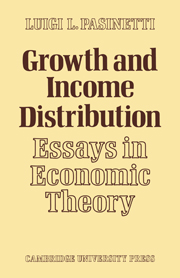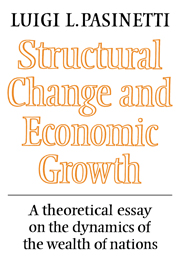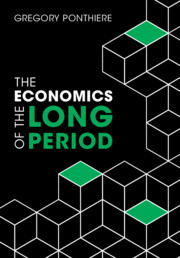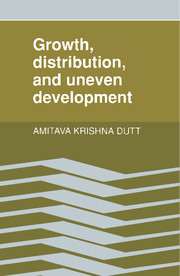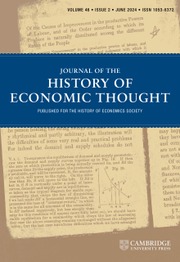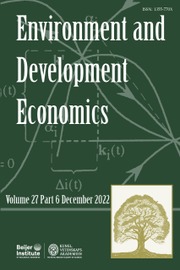Growth and Income Distribution
Essays in Economic Theory
- Author: Luigi L. Pasinetti
- Date Published: March 1979
- availability: Available
- format: Paperback
- isbn: 9780521295437
Paperback
Looking for an inspection copy?
This title is not currently available on inspection
-
This 1974 collection of six essays in economic theory represents a major contribution to the field. The first contains the formulation of the Ricardian system, whilst the next two contain, respectively, the author's synthetic treatment of the complex problems of fluctuations and economic growth, and his well-known theorem that in the long run the rate of profit and income distribution are independent of the propensities to save of the working class. The essays that follow provide the missing links: a coherent picture of the macroeconomic theories that have originated in Cambridge and a discussion of their deep foundations in classical economic analysis. Finally, the author evaluates some economic controversies and draws his conclusions on the basic forces determining rate of profit in the process of economic growth. Although the arguments are highly theoretical, they require no knowledge of mathematics beyond elementary calculus and algebra.
Customer reviews
Not yet reviewed
Be the first to review
Review was not posted due to profanity
×Product details
- Date Published: March 1979
- format: Paperback
- isbn: 9780521295437
- length: 164 pages
- dimensions: 216 x 140 x 10 mm
- weight: 0.22kg
- availability: Available
Table of Contents
Preface
Part I. A Mathematical Formulation of the Ricardian System:
1. Theory of value
2. Theory of distribution
3. Theory of economic growth
4. 'Natural' equilibrium in a two-commodity system
5. Some characteristics of the Ricardian system
6. The market solutions and the attainment of the 'natural' equilibrium
7. The equilibrium of the stationary state
8. The process of economic growth
9. Multi-commodity production
10. Concluding remarks
Appendix - existence and uniqueness of stable solutions
Part II. The Economics of Effective Demand:
1. Malthus on effective demand
2. The principle of effective demand
3. Theories of under-consumption (And over-production) 4. J. M. Keynes' 'general theory' of employment
5. The principle of effective demand in a different context
6. Ricardian features of effective demand in a different context. 7. Anti-Keynesian features of some 'Keynesian' literature
8. The principle of acceleration
9. Final remarks
Appendix - the 'lagged' multiplier
Part III. Cyclical Fluctuations and Economic Growth:
1. The model
2. A graphical device
3. The dynamics of income
4. The dynamics of the stock of capital
5. Interrelations between the dynamics of capital
6. The various interpretation of the endogenous dynamics of an economic system
7. Possibility of a steady growth
8. The difficulties of providing a theory which may explain both cycles and growth
9. A more flexible use of macro-economic models
10. A reinterpretation of the complex dynamics of a modern economic system
Mathematical appendix
Part IV. From Classical to Keynesian Economic Dynamics:
1. Pre-Malthusian Views on Population
2. Malthus' Principle of population
3. The 'law of diminishing returns'
4. Population growth and technical progress
5. Long-run equilibrium conditions - Domanr's contribution
6. The 'natural rate of growth - Harrod's contribution
7. New answer to an old Ricardian problem
8. Kaldor's theory of income distribution
9. Concluding remarks
Part V. Rate of Profit and Income Distribution in relation to the Rate of Economic Growth:
1. A post-Keynesian theory of income distribution and the rate of profit
2. A correction
3. Reformulating the model
4. Rate and share of profits in relation to the rate of growth
5. A fundamental relation between profits and savings
6. Implications
7. The conditions of stability
8. The case of a socialist system
9. Models and reality
Part VI. The Rate of Profit in and Expanding Economy:
1. Harrod–Domar's dilemma
2. The 'Cambridge equation'
3. The marginal productivity alternative
4. Extreme assumptions and general results
5. A first approximation synthesis
6. Irrelevance of the workers' savings required for the disappearance of the capitalists
9. Capital-output ratio and rate of profit
10. The case of a highly flexible capital-output ratio
11. Conclusions for the general case
12. Rate of interest and rate of profit
13. Many groups of savers
14. Further extensions
15. A socialist economy
16. The rate of profit in an expanding economy
References
Index.
Sorry, this resource is locked
Please register or sign in to request access. If you are having problems accessing these resources please email [email protected]
Register Sign in» Proceed
You are now leaving the Cambridge University Press website. Your eBook purchase and download will be completed by our partner www.ebooks.com. Please see the permission section of the www.ebooks.com catalogue page for details of the print & copy limits on our eBooks.
Continue ×Are you sure you want to delete your account?
This cannot be undone.
Thank you for your feedback which will help us improve our service.
If you requested a response, we will make sure to get back to you shortly.
×
